The update to IrishGenealogy.ie last month introduced several improvements, including a sleek, mobile-optimized design and enhanced search capabilities. Although some users have identified issues and glitches since the update, these are being actively addressed and resolved, which is positive news for the site’s future.
The IrishGenealogy.ie website received a substantial update in late February 2025, introducing several changes designed to improve accessibility and user experience. Operated by the Department of Tourism, Culture, Arts, Gaeltacht, Sport and Media, the site is a vital resource for genealogists and researchers worldwide, offering free access to Irish civil records and a selection of Irish church records.
A D V E R T I S E M E N T
Following the update, users quickly identified a number of issues, but many of these have since been ironed out. We would expect that any remaining problems will be addressed in due course.
Key changes to IrishGenealogy.ie
Having now tested the new interface, we can confirm several notable changes, which are outlined below.
– New design and user interface
The update brings a more modern, fresh, clean design with a streamlined appearance and improved layout. The website now uses larger text and more generous spacing.
– Mobile friendly
The updated site has been optimized for mobile devices, allowing users to access records more easily on smartphones and tablets.

– New search form
Previously, users had to choose between separate search pages for civil records and church records, whereas the updated site features a combined search form on the home page, offering a neater layout overall. This was probably introduced in an effort to streamline and simplify the search process.
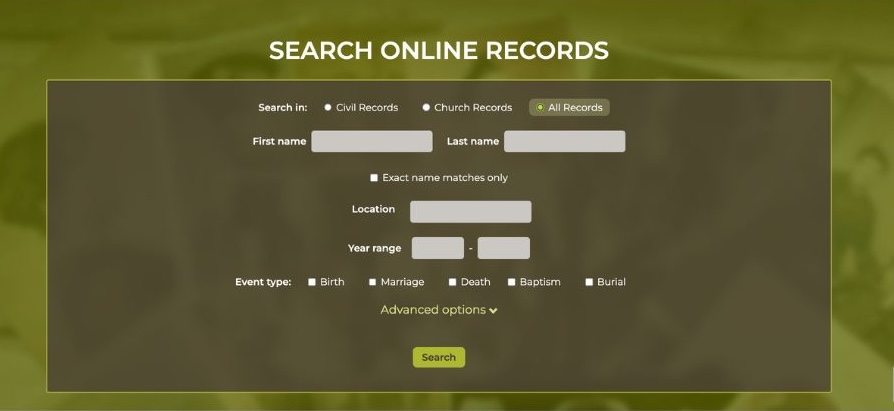
Users can choose to search exclusively within civil records, exclusively within church records or across all available records. By default, the system selects “All Records”, which many will stick with. However, opting for either civil records or church records provides greater control over search options and is the approach more experienced genealogists are likely to favour.
When “All Records” is selected, the search form includes fields for first name, last name, location and year range, along with an option to restrict results to exact name matches. Selecting “Civil Records” replaces the location field with civil registration district, which generates a dropdown list of districts as the user types. Similarly, choosing “Church Records” prompts a dropdown list of parishes in the location field.
Sign up to our newsletter
Users must also specify one or more event types. When “All Records” is selected, five options are available: birth, marriage, death, baptism and burial. For civil records, this is limited to birth, marriage and death, while church records offer marriage, baptism and burial. Searches cannot proceed without selecting at least one event type.
For civil records and for births, marriages or deaths within “All Records”, users must enter their name or initials in the Section 61 declaration box and must tick a box confirming their application to make the search in compliance with the Civil Registration Act 2004. The updated site has removed the CAPTCHA requirement.
– Advanced search options
Beneath the event types, the advanced options section offers additional filters, some of which were not previously available. Users can add extra details such as the day and month of the event, mother’s surname (for birth records only), age at death (for burial and death records only) or other recorded persons.
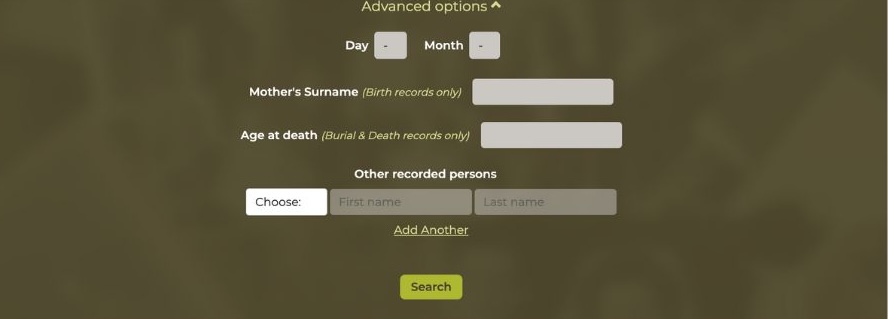
In the “other recorded persons” field, clicking “Choose” reveals a dropdown menu with several options:
- Spouse (marriage records only)
- Parent (birth and church marriage records only)
- Witness (church marriage records only)
- Sponsor (baptism records only)
A F F I L I A T E A D

You must have already selected an event type to access the dropdown options. Any unavailable choices will be greyed out. For example, the spouse option will be greyed out unless marriage has already been selected as the event type. To add a second other recorded person, users can select “Add Another”.
These advanced options performed well in our tests. However, a few users have encountered some issues that hopefully have been addressed.
– Search results: sort by and filters
The generated search results display 10 entries per page by default, with options to show 20, 50 or 100 results. Some users have claimed that the previous presentation of the list of search results, with its smaller text, was easier to scan. However, we found that the updated design still allows for easy scanning, as the most important details are highlighted in bold, capitalized, underlined text that stands out well.
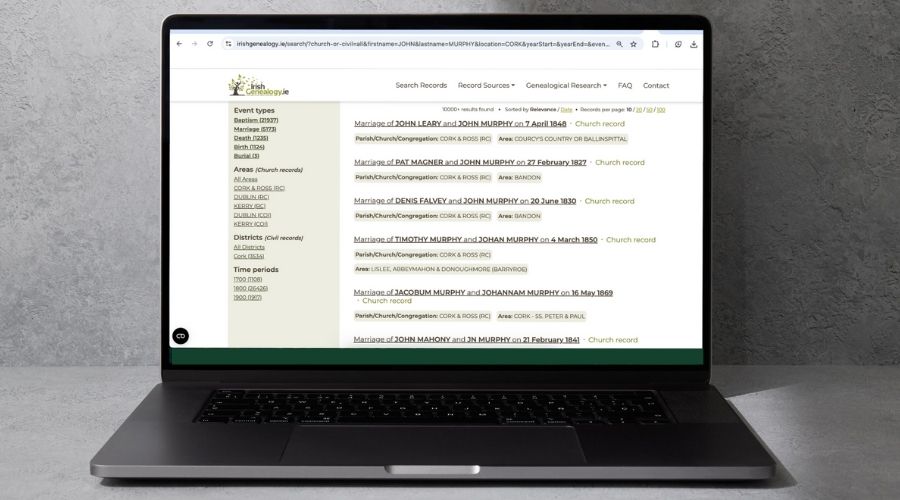
There are two sort-by options for the results: date and relevance. The relevance option is selected by default and it prioritizes results based on their relevance to your search parameters. The date option filters either by date of event or by date of registration (depending on the year and event type). For now at least, it appears that the date filter predominantly focuses on the year rather than being sensitive to the day or month.
Additional filters, located on the left side of the screen for desktop users, include event types, areas (for church records), districts (for civil records) and time periods, which are divided by centuries. However, we could not locate these filters when accessing the site on various mobile phones, but this feature will hopefully be extended to mobile users as well in time.
Users can click on any individual search result to view the transcribed index record details, which open in a new page. From there, they can usually click on a link to view the digitized microfilm image of the original record in a new tab (images can be downloaded in PDF format to your device for saving or printing).

There is also a “New Search” button that opens the search form on that page under the transcribed index details. This is a handy, time-saving feature; although, at present, the “Advanced options” are not functional when conducting a new search in this way.
However, if users don’t want to perform a new search and instead wish to return to their already generated search results, clicking to go back takes them back to the top of the results list. This can be somewhat time-consuming when working through a long list of results, as it requires extra scrolling down the page to return to your previous position, which may cause a bit of confusion about which record was just viewed.
A D V E R T I S E M E N T
– Missing dates and dating formats
For civil records, full dates for births, deaths and marriages are, of course, recorded in the register images, but errors have been noted in how dates appear in some search results and index entries since the recent update. Similarly, some errors in how dates appear have been observed in the search results for certain church records. We believe these are probably only temporary glitches.
- Births: The full date appears in search results and index entries for most 20th-century births, using the unambiguous fully written date format of 15 December 1906, while only the year is stated in the search results and index entries for most 19th-century births. However, some search results and index entries currently omit dates entirely. In these latter cases, the search results and index entries state: “Date of Birth: N/R” – our most recent searches, however, seem to indicate that this issue may now be resolved.
- Marriages: The full dates typically appear in both the search results and index entries / transcriptions for civil and church marriages. For users in the US, it is important to note that these are often quoted using the day/month/year format. For example, 03/08/1892 is 3 August 1892.
- Deaths: The search results and index entries for deaths often quote a year rather than a specific date. Again US users should be aware that when full dates are quoted in the index entries, they follow the day/month/year format. Currently the search results for some deaths are not showing any date (image below).
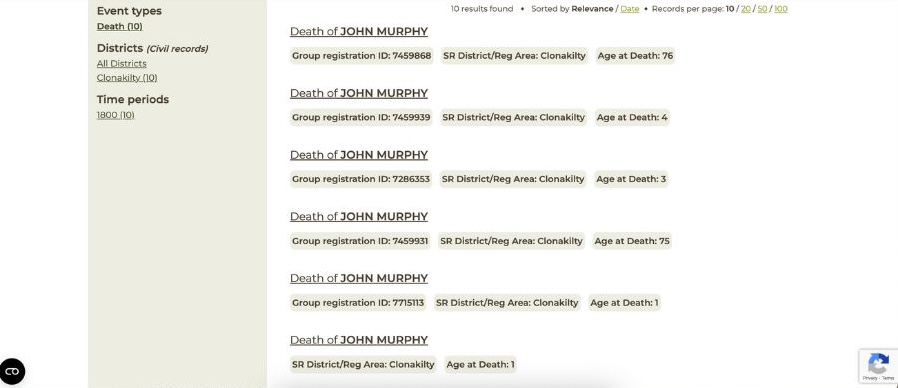
Sample of search results on IrishGenealogy.ie showing no date/year of death.
- Burials: The search results and transcriptions for burial records may quote either a year or a specific date. Some search results are not displaying any dates at present.
- Baptisms: The search results and transcriptions for baptismal records may quote a year or a specific date. Currently, in some cases, the results list only the day and year without the month. For example, we found search results displayed as follows: “Baptism of Jeremiah Hurley of Shanacrane on 18 1869” (image below). The transcription says he died on 18 December 1869 but the original record shows a date of 18 February 1869.

The inconsistency in how dates are presented on the site in search results and index entries / transcriptions can cause confusion, though it sometimes depends on the type of event or year, given the variations in information collected / indexed. As for the current missing dates, we can only assume that these are temporary glitches that will soon be fixed.
– Incorrectly indexed death dates
Some search results and index entries display death dates – particularly for the years 1864, 1865, 1866, 1867 and 1869 – that do not match the actual dates in the original records, which are later.
For example, the index entry for Isabella Pinkerton in the Cavan registration district currently gives a death date of 03/07/1864, while the register image shows she actually died on 25 August 1916. Similarly, the index entry for Robert Shaw in the Magherafelt registration district currently quotes a death date of 11/06/1864, but the register image indicates he actually died on 11 June 1892. We found records as late as 1970 mis-indexed as 1864.
Interestingly, the URLs for the register images (the PDFs) include the correct death years, suggesting that the records were initially indexed correctly. So, something seems to have gone wrong during the updating process, which may indicate a coding or data handling issue. Hopefully, this problem can be easily fixed.
A F F I L I A T E A D

It’s important to note that while index entries for deaths that occurred between 1864 and 1870 are available on the site, the register images for those years have never been made available online, though they are promised. You can easily identify true death index entries for these years as they will include additional information: returns year, returns quarter, returns volume number and returns page number – details that enable you to order the death certificate from the General Register Office (GRO). These indexes also lack the option to “View record image”.
– Missing record images and “Not Found” pages
Since the site was updated, we have encountered a few instances where clicking on “View record image” leads to a “Not Found” page, and the register image is unavailable.
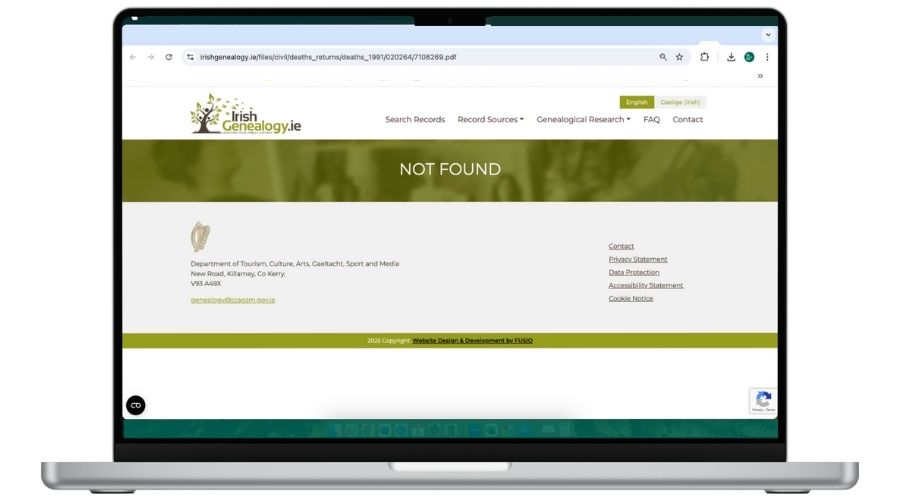
For example, the index entry for Timothy Kirby in the Cashel registration district lists a death date of 01/01/1864. When you click on the associated “View record image”, it opens a “Not Found” page. The URL for this “Not Found” page includes the year 1991, which may indicate that his death was only registered in this year though this remains to be seen.
Original church record images remain accessible on the site as before. However, some transcribed church records never had their original images linked to them, while some users have reported that others that did are now missing. Hopefully, this is just temporary.
Please help support
Irish Heritage News
A small independent start-up in West Cork
Give as little as €2
Thank You
In some cases where an image was never available, the site now provides a helpful link to the National Library of Ireland’s (NLI) general Catholic parish registers page. Here, users can search for the original record themselves using the details provided in the transcription. For example, the baptismal entry for Michael McGrath, dated 2 February 1859 in Castletownbere, provides a link to the NLI parish registers page but not directly to the record image.
– Carrick-on-Shannon and Carrick-on-Suir mix-up
Since the update, searching for records in the Carrick-on-Shannon registration district also returns results for the Carrick-on-Suir registration district, and vice versa. This mix-up suggests a coding error linking the two locations. Users should be aware of this issue when searching for records from either area, as results may include entries from the wrong place. We expect this problem can be easily resolved.
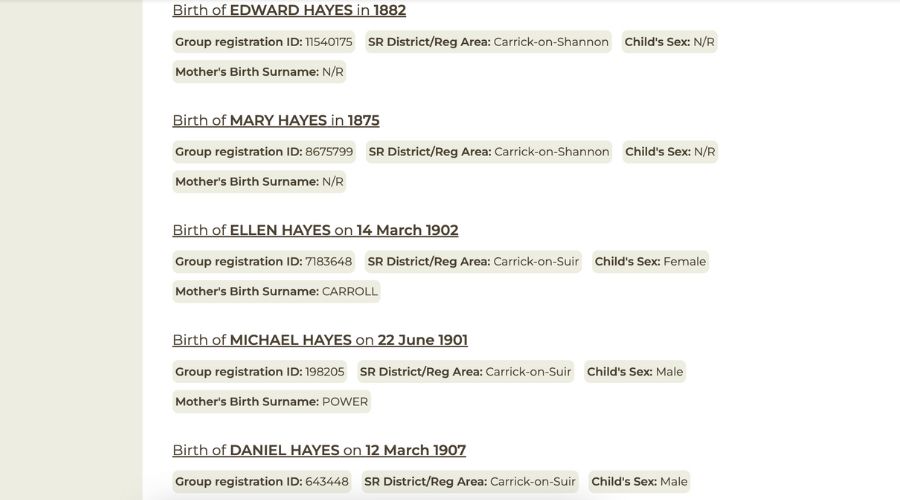
– URLs (links)
Since the update, the URLs have changed. Initially, old URLs that users had saved and bookmarked did not redirect to the new ones and instead led to error pages or redirected to the main search page instead of the intended record. However, this problem has since been resolved, and old URLs now correctly redirect to the updated addresses, ensuring continued access to previously saved records, which is a very positive development.
While the redirects are currently functioning, it remains unclear whether these redirects will be permanent. Therefore, we recommend updating any links saved in your records or family trees on genealogy sites like FindMyPast, Ancestry and MyHeritage to ensure long-term access. In addition, it’s always a good idea to save the record images as PDFs on your device (or screenshot them) and attach the files directly to your family tree.
A D V E R T I S E M E N T
For any users still encountering issues with old URLs, it is possible to rewrite them to align with the new structure. A helpful video tutorial by Daniel Loftus explaining this process is available on YouTube.
(Note: While IrishGenealogy.ie has implemented redirects, the new census system does not facilitate redirects from their old URLs. More on this here.)
>>> READ MORE: Navigating the new system for Irish census records launched by the National Archives
Other helpful resources and features
The site now offers much additional information to support genealogical research. There is a help section for civil records and a separate help section for church records, along with details on record sources and an FAQ section. Users can also find general guidelines on how to conduct family history research, as well as a list of useful research supports and publications. The site features lists of external resources covering names and placenames, military and police records, graveyards and records of the Irish diaspora.
Users can toggle between English and Irish to view the site in either language at the top of the screen on desktops and at the top of the menu on mobile devices.
Reporting issues
The major redesign of the website has sparked discussion among professional genealogists and family history enthusiasts alike on platforms like RootsChat and WikiTree, as well as in various Facebook genealogy groups. Many of the early glitches have, thankfully, been resolved.
If you encounter any issues, you can report them by filling out the contact form here or by emailing genealogy@tcagsm.gov.ie. If your issue relates to a particular civil record, you can click “Report any error in transcription” or “Report problems with image” at the bottom of the index entry and provide the relevant information.
Sign up to our newsletter
It is anticipated that all issues relating to the site’s update will be resolved promptly.
Quick links
What civil records can be accessed on IrishGenealogy.ie?
IrishGenealogy.ie provides access to civil records from the GRO – birth, marriage and death records – under the 100-75-50-year rule. This means that birth records over 100 years old, marriage records over 75 years old and death records over 50 years old are available on the site. The records currently accessible include:
- Birth register records: 1864–1924
- Marriage register records: 1845–1949
- Death register records: 1871–1974
More on what civil records are and aren’t available online here.
>>> RELATED:
The civil records on IrishGenealogy.ie are updated annually, with each update adding another year’s records. Many had expected the 1924 births, 1949 marriages and 1974 deaths to be added when the site got its recent facelift, but these have yet to be released.
A D V E R T I S E M E N T
Professional genealogist Claire Bradley, Director of Irish Studies at the International Institute of Genealogical Studies, recently contacted IrishGenealogy.ie to ask about the next release of records. They responded by saying that they are waiting until the newly updated site has been thoroughly tested before adding the next year’s records, but they should be made available soon.
What church records can be accessed on IrishGenealogy.ie?
IrishGenealogy.ie provides access to a substantial collection of pre-20th-century church records in the form of baptismal, marriage and burial records, many of which predate civil registration. This includes:
- Transcripts and (some) images of Church of Ireland baptism, marriage and burial registers for Carlow.
- Transcripts and (some) images of Roman Catholic baptism, marriage and burial registers from the Diocese of Cork and Ross (some Cork city parishes are unavailable).
- Transcripts and (some) images of Roman Catholic and Church of Ireland baptism, marriage and burial registers for Dublin City (St Paul’s, Arran Quay, is unavailable).
- Transcripts of some Presbyterian records relating to a congregation in Lucan, Co. Dublin.
- Transcripts of Roman Catholic baptism and marriage records from the Diocese of Kerry (includes some parishes in western and northwestern Cork).
- Transcripts and record images of Church of Ireland marriage, baptism and burial records in Kerry.
Advertising Disclaimer: This article contains affiliate links. Irish Heritage News is an affiliate of FindMyPast. We may earn commissions from qualifying purchases – this does not affect the amount you pay for your purchase.
READ NOW
➤ Talking to older people: questions to find out about Ireland’s past and your roots
➤ Navigating the new system for Irish census records launched by the National Archives
➤ Did your ancestor spend time in a workhouse?
➤ Understanding marriage settlements for Irish family history research
➤ A genealogist’s guide to DNA testing for Irish family history research
A D V E R T I S E M E N T

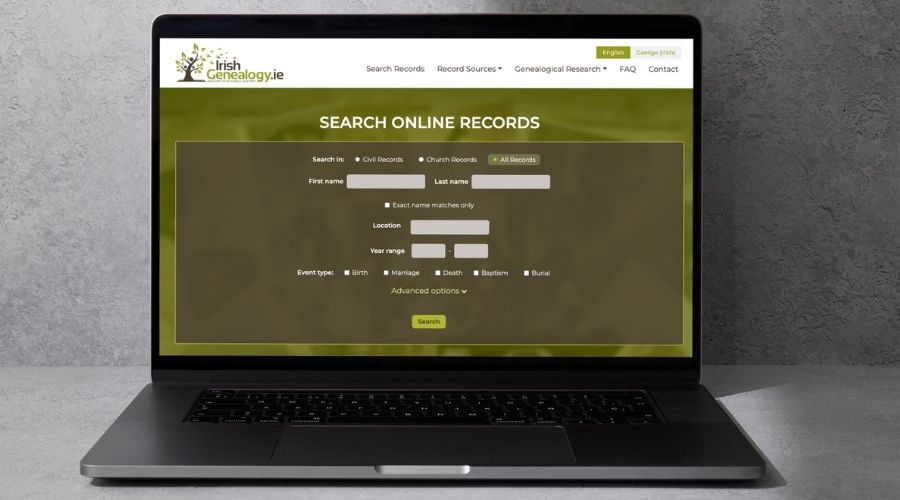



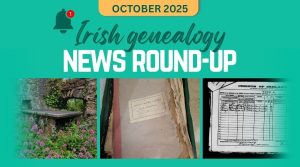
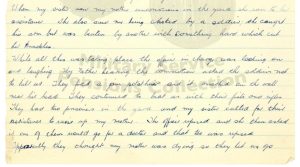



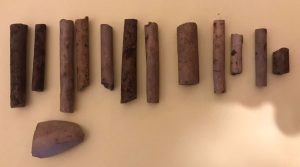
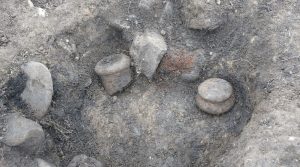



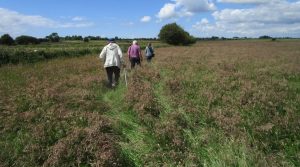
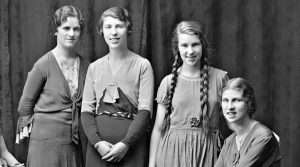



2 Responses
I was so annoyed to discover these changes recently.
You used to be able to search for a name or surname and have returned all instances of that name or surname, whether as the primary individual, a parent, or a witness and so on.
This was really useful with relatively rare names because you could for example quickly look up all children of a marriage, or all baptisms or marriages where a certain surname was a witness.
This could really do with being fixed.
The advanced search options are not working for me! So annoying as before the update, I used this frequently to find all the siblings in one family knowing the paternal surname and mother’s surname. I have emailed them twice to let them know it is not working, but haven’t received any reply. UGH!!!